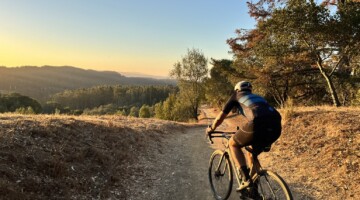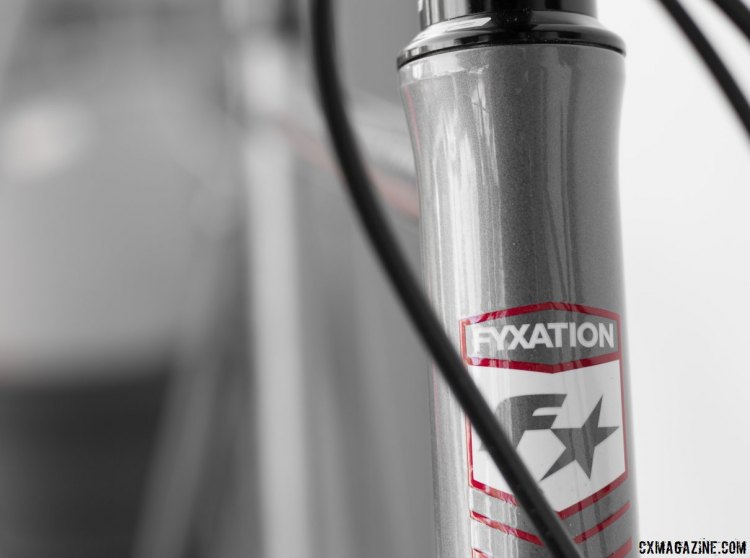
The name Fyxation might conjure up images of hipsters on fixed gears, but the brand quietly now offers more offroad-capable bikes than road bikes. © Cyclocross Magazine
See the name Fyxation in the subject line of an email or in an article title, and if you’re a cyclocross or gravel specialist, you can be forgiven for scrolling past it.
Fyxation, in large part due to its name and urban bike and tire roots, is likely to be associated with other companies like Pure Fix and State Bicycle Co. that cater to the fixed gear and singlespeed crowd. However, while most of us weren’t looking, Fyxation has quietly transformed itself into a company that serves the offroad crowd, with four of its five models now offroad oriented or capable, and just one being fixed gear/singlespeed model.
The company’s steel do-it-tall Quiver is not a new bike, but since its inception a few years ago, the line has expanded to include two 4130 steel versions, one with cantilever brakes and one with disc brakes that we first saw back at Interbike. Cyclocross Magazine has secured a test bike that is under review, and here are some initial images, observations and impressions. Stay tuned for our full review.
Fyxation Quiver Disc: The Frame
The original Quiver was thus named to indicate its multi-use capability. Regardless of whether you are using your Quiver for road riding, commuting, weekend touring, cyclocross, bikepacking or all five, this bike has the ability to do it without you needing to take out a second mortgage or fill up the garage with specialty bikes.
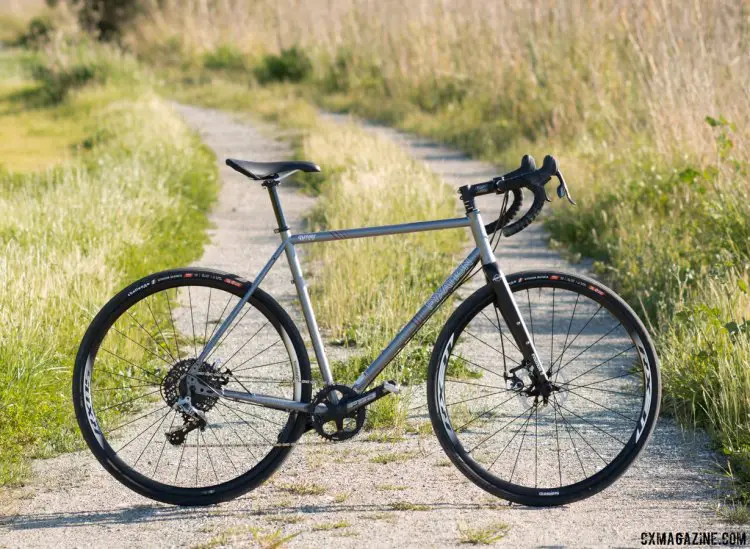
The Quiver Disc demonstrates Fyxation is serious about getting out of the urban environment, and it does well exploring outside the beaten path. You’ll want bigger rubber for rockier gravel or trails. © Cyclocross Magazine
The Asia-built 4130 cromoly frame and fork keep the bike affordable and versatile, with different frameset fittings for different uses. For example, the the Quiver Disc has two water bottle mounts on the frame and two on each side of the cromoly or carbon fork. There are also plenty of rack and fender mounting options.
Want to save a pound? Fyxation now offers its carbon Sparta fork with a full set of rack/fender/adventure mounts. The fork features an alloy straight 1-1/8″ steerer, 400mm axle-to-crown and 45mm rake.
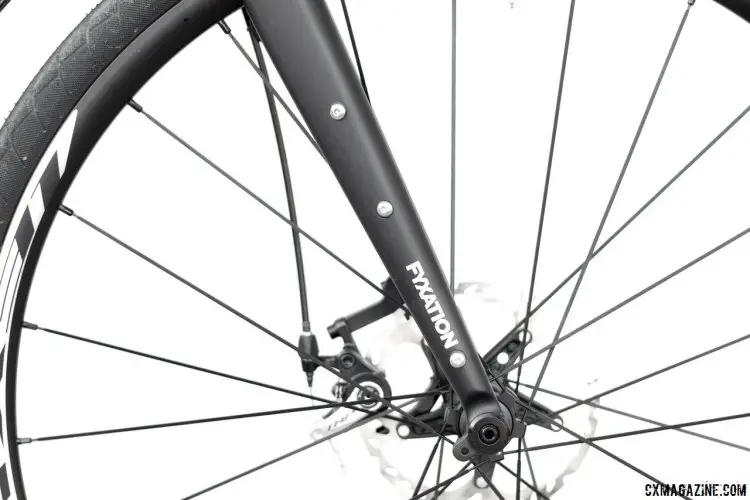
Fyxation Quiver Disc with Sparta carbon fork upgrade brings weight savings and front bottle cage, rack and fender mount options. © Cyclocross Magazine
Although the frame and fork originate from overseas, each bike is assembled in Fyxation’s Milwaukee headquarters to keep control of the build quality and to ensure the buyer has an easy time with the basic assembly. By adding disc brakes, Fyxation has increased the versatility of this bike, making for a modern setup that makes swapping in 650b wheels an option as well.
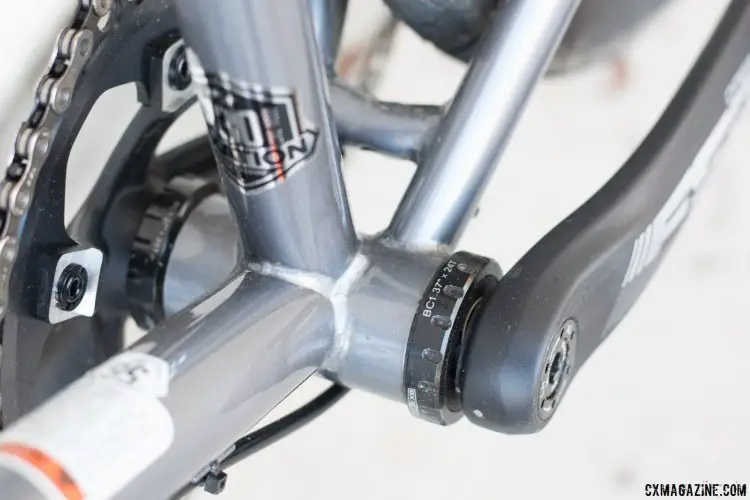
Threaded bottom bracket shell keeps maintenance easy and pedaling quiet. Fyxation Quiver Disc with Sparta carbon fork. © Cyclocross Magazine
The frame offers internal top tube routing for a front derailleur, but external routing for the rear brake and rear derailleur. It’s a curious choice, and the open ports when running a single chainring remind you of what’s missing. We’d think it’d make more sense to route the rear brake or rear derailleur housing internally, since most owners will be requiring both of those, with or without a front derailleur. To prevent against the tubes filling up with water, or you accidentally cutting yourself on the metal edge, they should probably be covered or plugged in a 1x build. Or you can use the ports for a cable-actuated dropper post.
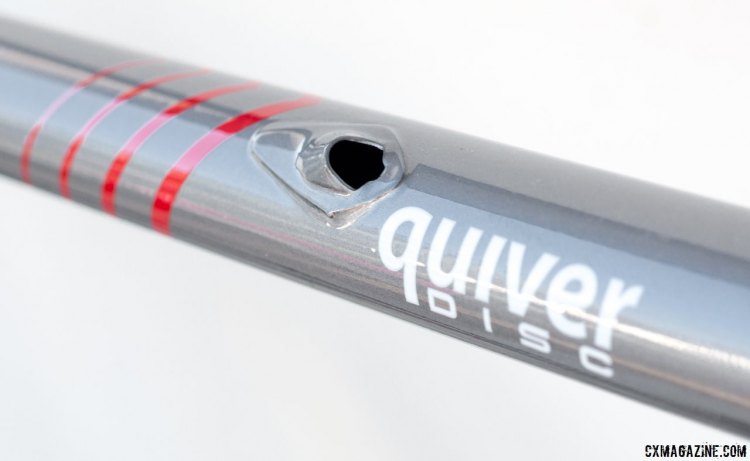
Fyxation Quiver Disc internal routing for a front derailleur, but you’ll want to close up the open housing ports for rainy rides, or to protect you from the sharp edges . © Cyclocross Magazine
The Fyxation Quiver Disc has “relaxed road” geometry and our 56cm test bike has a 73.5 degree seat angle, 72 degree head angle, with 70mm of BB drop (same for all sizes) and 427mm chainstays—just 2mm longer than the common cyclocross standard. The bike is available in six sizes (46, 49, 53, 56, 59 and 62cm) and should fit riders from 5’0″ to 6’6″ according to the Fyxation website. It’s a relatively aggressive, low center of gravity design—not a laid-back touring geometry.
Fyxation Quiver Disc: The Build
Fyxation creatively combines components from SRAM, Shimano, FSA and TRP into an affordable, smoothly-running group.
The wide ratio 1x drivetrain pairs an FSA Megatooth 42 tooth chainring up front with a SRAM Apex 1130 11-42t cassette in the rear. The two are mounted to an FSA Omega crankset and Shimano wheelset, respectively. The versatile gearing should provide for enough gearing for all but the most extreme climbs, road hammerfests or gear-laden adventures.
Fyxation also offers a 2×10 Shimano Tiagra version at an even more affordable price ($1,095). It should be noted that unlike the canti version of the Quiver, you can’t run a belt drive on the Quiver Disc.
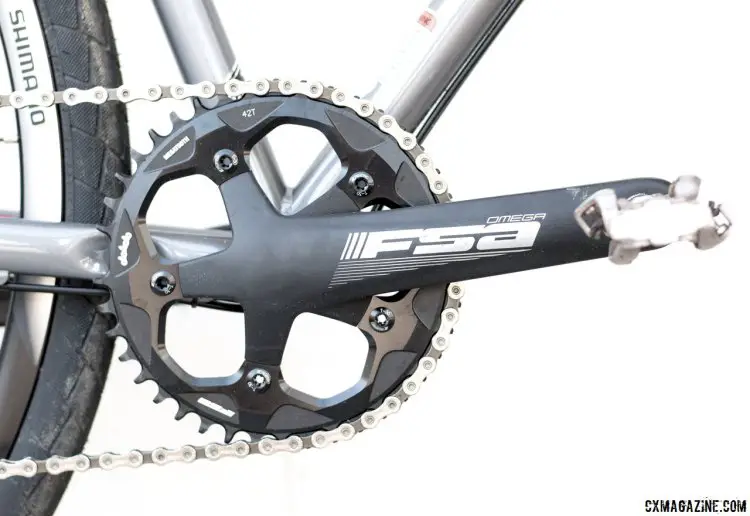
The Fyxation Quiver Disc mixes componentry, with an FSA Omega crankset with Megatooth wide/narrow 42t chainring. © Cyclocross Magazine
As can be expected, the Quiver is kitted with plenty of Fyxation branded parts like the bar tape, seatpost, saddle and tires. FSA provides the cranks, bottom bracket, handlebar, headset and stem. The FSA Compact bar is quite narrow for a 56cm bike, measuring 40cm c-c at the hoods, and 42cm at the ends.
It’s worth noting that if you opt for the $145 upgrade to the carbon 12mm thru axle Sparta fork, the company swaps out the Shimano RX05 front wheel for the Shimano RX31 model. Neither are tubeless ready nor particularly wide (17mm internal width). Looking at the inner rim profiles, these rims aren’t great conversion candidates due to a small shelf and giant center channel, but determined DIYers might still try. We didn’t bother.
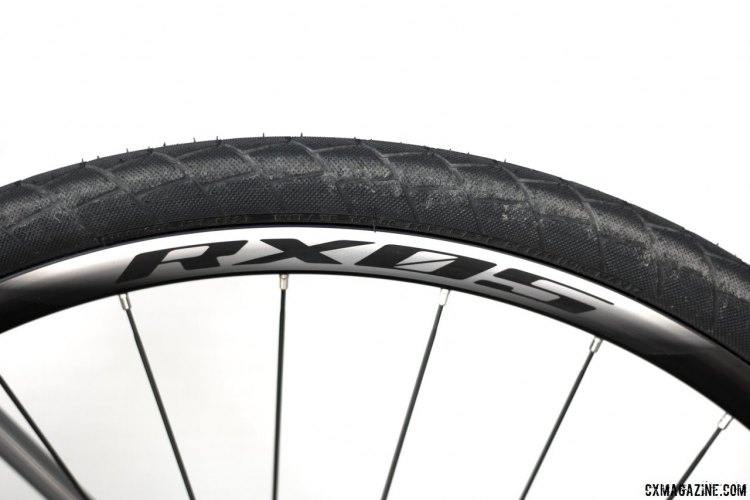
Fyxation Quiver Disc with Sparta carbon fork requires a split wheelset, with a non-tubeless Shimano QR RX05 wheel out back and thru axle RX31 up front. Shimano and SRAM work well together.© Cyclocross Magazine
On such a bike, for offroad use, we’d much prefer tubeless options, and there should be tubeless wheels at a comparable price. Thankfully, Fyxation allows prospective buyers to customize their ride, and that’s an option the company is happy to discuss. Fxyation also runs a pretty comprehensive online store (and brick and mortar retail location), so it has diverse build options available.
Fyxation got its start by launching a durable, urban oriented tire that would hold up to fixed-gear braking, and so it’s only natural that the company includes its heritage product on the Quiver Disc build. However, the 700×35 Session wire bead tire, with its bead-to-bead tread, high durometer rubber and Kevlar belt might be built to withstand city and commuting abuse, but certainly aren’t what anyone would call supple.
Due to the attempt to keep the bike affordable, the entire build adds up to a hefty package. The complete bike weighs 25.55 pounds with the Sparta carbon fork. Keep the stock steel fork and you’ve got $145 more in your wallet and another pound to carry around. Yes, it’s steel and under $1500, but it’s still heavier than many front suspension mountain bikes. The CXM without-wheels weight is a whopping 16.9 pounds. That’s not light either, considering the Rival 1 build and carbon fork. If you’re looking for a commuter or bike packing bike, weight likely won’t matter, but it’s worth considering if you hope to race a cyclocross race or climby gravel event.
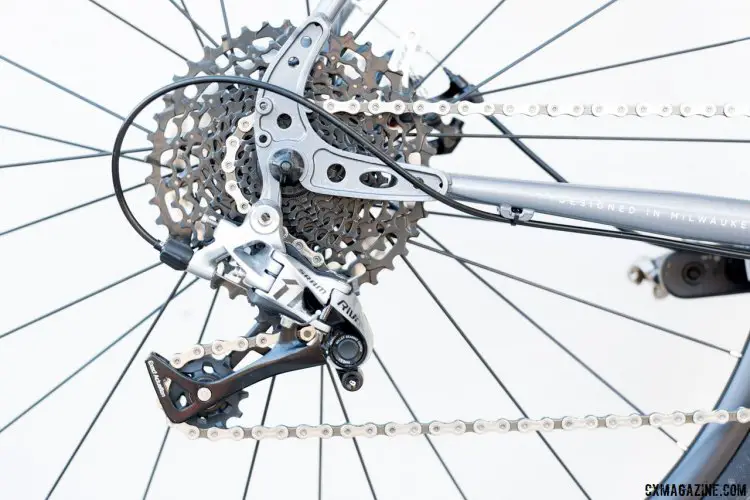
Fyxation Quiver Disc with Sparta carbon fork features a SRAM Rival 1 rear derailleur and Apex 11-42 cassette. © Cyclocross Magazine
Fyxation thankfully has no problem sharing frame weights, stating our 56cm frame weighs 5.68 pounds, and the carbon fork is 1.64 pounds (747 grams). Those weights suggest there’s room to save grams on items like the cockpit and crankset, if that’s your eventual goal.
It’s also worth noting that rear dropout spacing is 132.5mm. We don’t see many 130mm disc wheels around, but if you’ve got them, they’ll fit on the Quiver Disc, as will modern 135mm quick release options. It’s an interesting option that makes the bike even more versatile, but could make wheel installation a bit more inconvenient for the masses with 135mm wheels. However, in the process of replacing the rear wheel after swapping out the tire, we barely noticed the tighter spacing.
Fyxation Quiver Disc: Ride Impressions
We don’t spend much time on pavement or on road bikes at Cyclocross Magazine, but hopping on the Quiver Disc, it’s easy to feel like you’re on a classic steel road bike. The relatively narrow FSA bars (40cm center-to-center at the hoods), paired with a low 7cm bottom bracket drop, medium diameter steel tubes and relatively upright frame angles almost make you feel like you’re ready to line up for L’Eroica to ride with Tom Ritchey and Andy Hampsten, even if the bike violates most of the rules. It’s at home equally on countryside pavement as it is on gravel roads or trails, and feels much more road-oriented than the recent crop of adventure-oriented bikes we’ve been riding, like the Bombtrack Hook EXT.
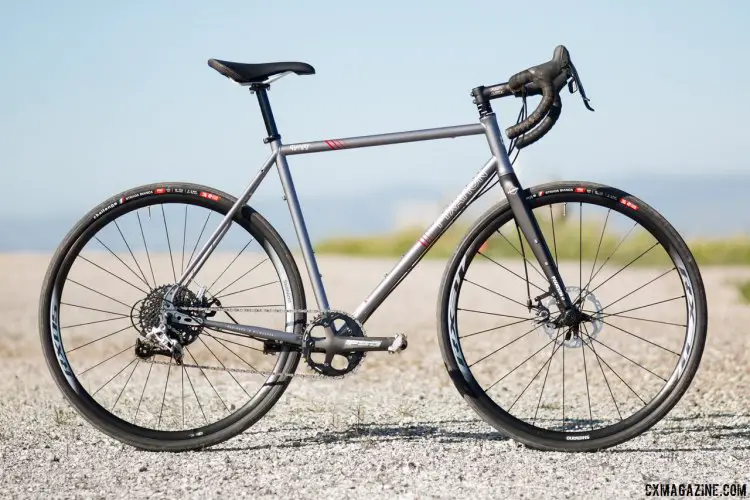
Fyxation Quiver Disc with Sparta carbon fork rides like a traditional old-school road bike, with a low bottom bracket, steel frame and narrow bars. The carbon fork and a tire swap (Challenge Strada Bianca pictured) improves ride comfort . © Cyclocross Magazine
First rides on the Quiver Disc showcased two attributes of the stock bike (with Sparta carbon fork)—one being permanent and the other easily altered. The frame and fork aren’t rigid boards designed for bunch sprints. They both have some noticeable flex on big hits or under hard sprinting or cornering efforts. This flex is welcomed for mixed terrain and gravel riding, but despite that flex, initial rides were overly harsh. You can feel nearly every crack in the road, every pebble, at almost any tire pressure. It’s the stock Session tires, built to withstand months of fixed gear skidding with thick, high durometer rubber, that are responsible for that unwelcomed initial ride impression. Even at 20 psi, the 600 gram 35c tires (measured at 34mm on the Shimano hoops) felt like they were at 60 psi.
After swapping out the Session tires for a set of 36mm Challenge Strada Bianca open tubulars (also measured at 34mm), we noticed not only a 300g rotating weight savings, but an immediate reduction in road vibration. Now, gravel and dirt roads were far more alluring. We explored, got dirty, found some mud and even did some skidding. The early verdict? The Quiver Disc is at home doing anything from road riding and commuting to gravel roads and cyclocross, as long as you can handle the heft and narrow tube on your shoulder (and avoid the housing port) during run-ups.
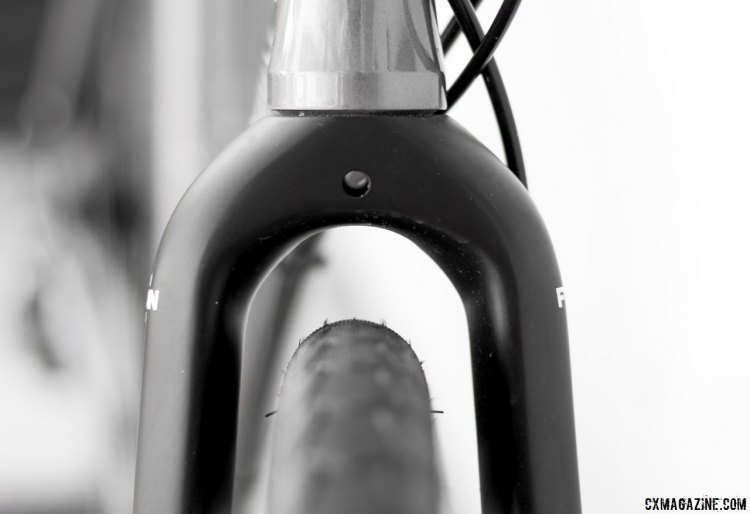
The Fyxation Quiver Disc with Sparta carbon fork. The fork has clearance for 42c tires, and fittings for rack and fenders and bottle cages. © Cyclocross Magazine
Where the Quiver Disc starts to hit its limits is on rocky, technical descents. The relatively quick steering and low bottom bracket offer road bike-like handling, especially on the 34mm slicks. That quick steering is nice on low-speed singletrack, but add some speed and some rocks and you might be testing the TRP Spyre brakes. Bigger tires will likely slow the handling a bit. The Quiver Disc is more road-oriented than many bikepacking options, yet has plenty of fittings to carry all your gear.
Stay tuned as we test the bike on more terrain, with other tire and wheel options.
Early Verdict
Whether you want to start a one-bike quiver on a budget, need an affordable commuter, or want to add some offseason tire clearance and adventure, the Quiver Disc is an impressive value and attractive option. The plethora of accessory fittings, threaded bottom bracket and forgiving ride quality are all wins. We’d like better stock rubber, wider bars and could do without the (unused) front derailleur housing routing, but these are minor gripes on an under-$1500 bike. As for the weight? That’s a heavy topic, but such a versatile bike could really lighten your quiver.
Full specs and photo gallery below.
Andrew Yee and Gregg Kato contributed to this article.
Fyxation Quiver Disc Specs:
MSRP: $1495 as tested complete ($479 frameset, $1350 with steel fork, other builds available)
Frame: Fyxation Quiver disc frame, 4130 cromoly
Fork: Fyxation Sparta carbon fork ($145 upgrade), 12mm thru axle
Rear Derailleur: SRAM Rival 1 11-speed
Front Derailleur: n/a
Shifters: SRAM Rival 1 11-speed
Cassette: SRAM PG 1130 -11-42t
Crank: FSA Omega w/Megatooth 42T wide/narrow chainring
Bottom Bracket: FSA Omega external cup
Brake Calipers: Tektro Spyre CX
Brake Levers: SRAM Rival
Handlebar: FSA Omega, 31.8mm clamp, 40cm c-c at the hoods
Bar Tape: Fyxation Loop EVA tape
Headset: FSA Integrated IS41
Stem: FSA Omega, 31.8mm clap
Seatpost: Fyxation Pilot micro-adjust
Saddle: Fyxation Pilot performance saddle
Wheels: Shimano quick release RX05 Disc 28 rear, RX31 thru axle front
Tires: Fyxation Session 700x35c wire bead, 600 grams each
Tire Clearance: 700x42c or 700x35c with fenders
Warranty: 3 years on frame and fork against manufacturer defects, 1 year on all other non-consumable parts (tires, tubes, saddles, paint, handlebar tape, grips, etc. are considered consumable parts)
Weight: 25.55 pounds, 16.92 pounds without wheels
More info: fyxation.com
Fyxation Steel Quiver Disc Bike with Sparta Fork Photo Gallery:


























